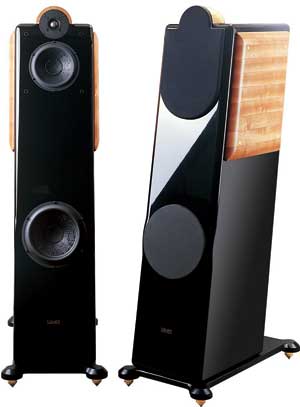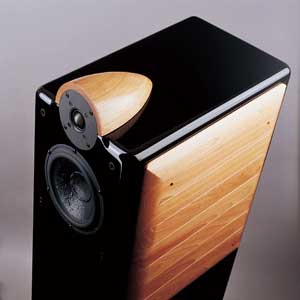 |
|||||||
| |
|
|
|
 |
|
|
|
Appearance & Set-up In addition to the rearward cant, which is designed to aid time alignment and phase accuracy of signals arriving at the listening position, each speaker has thick wooden cheeks affixed to the sides adjacent to the tweeter-mid drivers. Beautifully finished, these may be more than a design element, as they likely add further rigidity, and vibration control, to an already inert-feeling cabinet. Each speaker is indeed a heavy beast, stabilized by a 30-pound cast iron base, the attachment of which took some ingenuity. I recall reading that one reviewer threatened to crush the tweeter assembly, which rises above the speaker’s top not unlike B&W models, by inverting the speaker onto its head in order to attach the base plate. I placed the 6381 on its side, propping up the bottom with a rather large dictionary. In this position it was much easier to affix the base to the bottom, though holding up 30-pounds with one hand while tightening the attachment bolts with the other does require some skill, dexterity and strength. Much easier to have a friend help with this. Once assembled, the 6381s were placed in the usual speaker position in my listening room, approximately 24 inches from the front wall and 36 inches from the side walls. Surprisingly, while most speakers fare best in this position, the 6381’s bass overwhelmed the room, which measures 15’ x 25’ x 18’ (W x D x H). Fiddling and diddling with the position resulted in speaker placement well into the room, approximately four feet from the front wall and three feet from the side walls. As anomalous as this placement was, the sound (more on this later) that filled the space indicated that the positioning was spot on. At this point, the speakers were spiked (with heavy cones) and, thanks to each speaker’s sheer solidity and mass, the spikes drove comfortably through the carpet and padding, anchoring themselves on the plywood subflooring. On each speaker’s back side, you’ll find two sizable ports, one for the tweeter-mid drivers, and the other for the woofer section. At the very bottom of the back side, you’ll find a plate secured by bolts. Behind the plate is a cavity into which you can load sand or shot and, according to Usher, doing so will tighten an already good bass response. Just above the cavity door, one finds a recessed cavity containing a pair of binding posts. The cavity is such that large WBT-style spade lugs will not likely fit: Fitting the modest Nordost Valhalla spades proved to be enough of a problem. You’ll be best served using banana plugs in this rather tight environment. Sound For this review, the all-tube (now you know my bias) core system contained a Singerman-modified (audio circuit) Jolida JD100 CD player, Song Audio SA-1linestage, and conrad-johnson Premier 140 amplifier. During the review I would rotate in and out a conrad-johnson 17LS linestage and the Antique Sound Lab Hurricane monoblock amplifiers. Other staples of the system included the Nordost Thor distribution system (reviewed in Vol. 16 No. 4) and (updated) Sound Application CF-X conditioner. Nordost’s Valhalla wired the entire system. Irrespective of whether the core system was in use or substitutions were inserted, the one incontrovertible pronouncement that can be made about the Usher CP-6381 is that it presented holographic musical sound-scapes that surprised and delighted. With the core system, I found a finely textured presentation. Plucked guitar strings, whether steel or gut, had the requisite bite, yet also a density of harmonic structure. The piano’s high notes had that special sting while the notes below middle C had a fundamental fullness and richness. I could readily distinguish between the strike on the bell portion of a cymbal and the strike on its broader surface. These qualities alone made listening to everything from rock to jazz to string quartets to larger-scale orchestras an engaging, and often revelatory, joy. Today, the term ‘transparent’ is lobbed about in reviews with such regularity that I hesitate to use it. However, with the core system driving the Ushers, I sensed a see-throughness into the sound space that is rare, especially with many speakers in this price range. After a great deal of thought, the best answer I can muster for this seems to lie in the speaker’s ability first to easily identify the various harmonic layers presented to the drivers and then deliver them into the room (room interactions, aside) without congealing or melding them into less coherent structures. The net result is that one hears more of the musical line, the interactions between notes and chords and the like, across the soundspace, from drum heads to bowed bass strings, from metal horns to reeds. Music makes more sense this way. When it came to dynamics, I was indeed surprised by the power of the small eight-inch bass drivers. Although my room does bass exceedingly well, with the Usher’s in place it sounded tight and resolute without being overly dry or boomy. Bass was precise enough, even though the speakers don’t handle the last half-octave of bass. Never mind that, my viscera have no need of peristaltic activation, thank you. But a good kick drum, exploding from the back of a stage is something else, the anchor for so much rock, and with the Usher’s you get plenty of that, most often in appropriate size as well. Whether I played the core system or dropped in the 17LS or the Hurricanes (each substitution tending toward just a bit more coolness than the core system), the results were similar: Musicality, density, solid image placement, dynamics and listenability. Regardless of system set-up, I found I could listen for extended periods, enjoying the music.
At $3,400 per pair, the Usher CP-6381 is a magnificent bargain, especially for the tube-loving fool. You’ll likely understand your music collection better, appreciate it a helluva lot more, and consider yourself no one’s fool when it comes to sparing your cheque book. Of course, I cannot tell how these speakers would fare with solid-state gear, but I suspect the team of Lien-Shui/D’Appolito has taken that into consideration. At each of Usher’s hi-fi show outings, the entire Usher speaker line has been driven by solid-state gear (Usher’s own brand, in fact), and it has not failed to impress the crowds. The Usher CP-6381 may not deliver the ultimate in presentation refinement or sense of air delivered by other brands, but then those other brands will cost you significantly more for that incremental pleasure. Thus, the CP-6381 becomes, at its price, a visual statement and sonic masterpiece for real-world audiophiles who desire a goodly taste of the indescribable that is music.
|
|
| News | Reviews | Commentary | Marketplace | Contact Us | Home |

